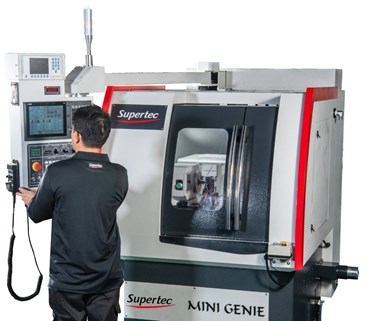Supertec's Mini Genie Cylindrical Grinder Capable of 600 rpm
Supertec Machinery’s Mini Genie cylindrical grinder is designed for shops with limited floor space.
Share




.png;maxWidth=45)
DMG MORI - Cincinnati
Featured Content
View More

Takumi USA
Featured Content
View More




Autodesk, Inc.
Featured Content
View More
ECi Software Solutions, Inc.
Featured Content
View More
Supertec Machinery’s Mini Genie cylindrical grinder is designed for shops with limited floor space, with a footprint of 78" × 78" (43 sq. ft.). The machine provides grinding diameter capacity of 9", a distance between centers of 8", and a work load capacity of 44 lbs between centers (11 lbs chucked). The wheelhead uses an NN contact taper needle roller bearing spindle with a 20" × 2" grinding wheel and 10-hp spindle motor, enabling greater stock removal rates. Featuring infinitely programmable speeds, the workhead can reach 600 rpm. The machine can grind materials such as cast iron, Inconel, carbide and chrome.
Equipped with a Mitsubishi M80 control and Supertec’s I-Grind conversational shopfloor language, the grinder is said to be easy to program. The graphic display screen allows the operator to review the part program prior to grinding and make any required adjustments. The Mitsubishi M80 (and optional FANUC Oi-TF) control can be interfaced to a variety of measurement systems such as touch probes and automatic sizing devices as well as robotic and gantry-style automatic loading systems.
The Mini Gene comes in two styles, a plunge model with the wheelhead set at 90 degrees and an anglehead model with the wheehead set at 20 degrees. The anglehead is well-suited for faster stock removal and a better surface finish on face and shoulder grinding applications, the company says.
A Heidenhain 0.000002"-resolution linear scale is used for improved accuracy and repeatability, enabling the achievement of 0.0001" or better tolerances, according to Supertec. Both machine axes use linear guideways for smoother more accurate movement.
Other standard features include a full enclosure, an infinitely variable workhead, a coolant system with paper filter and magnetic separator, and a taper-adjustable tailstock.
Related Content
-
The Future of High Feed Milling in Modern Manufacturing
Achieve higher metal removal rates and enhanced predictability with ISCAR’s advanced high-feed milling tools — optimized for today’s competitive global market.
-
CNC Machine Shop Honored for Automation, Machine Monitoring
From cobots to machine monitoring, this Top Shop honoree shows that machining technology is about more than the machine tool.
-
How to Mitigate Chatter to Boost Machining Rates
There are usually better solutions to chatter than just reducing the feed rate. Through vibration analysis, the chatter problem can be solved, enabling much higher metal removal rates, better quality and longer tool life.





.png;maxWidth=150)
























.jpg;maxWidth=300;quality=90)


